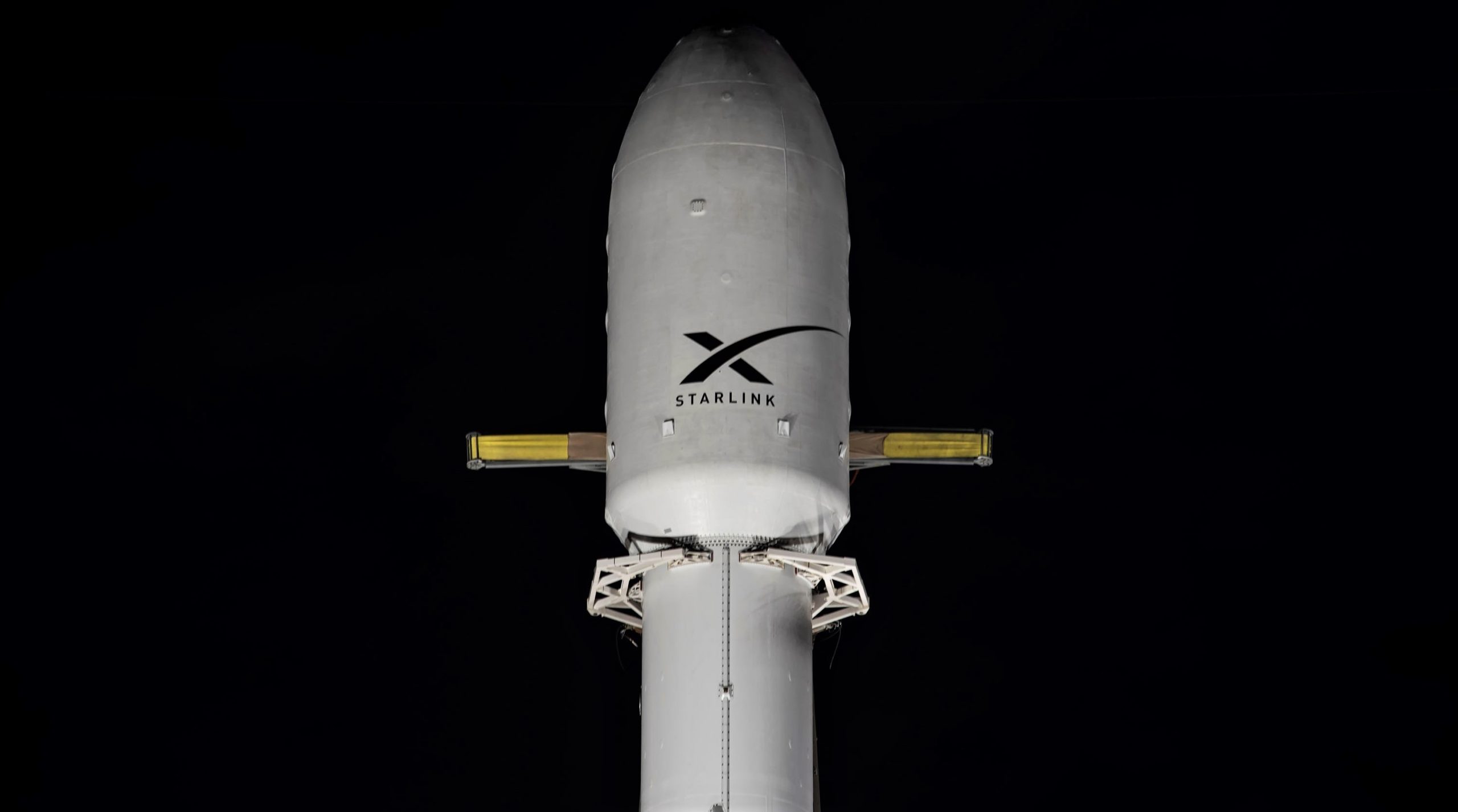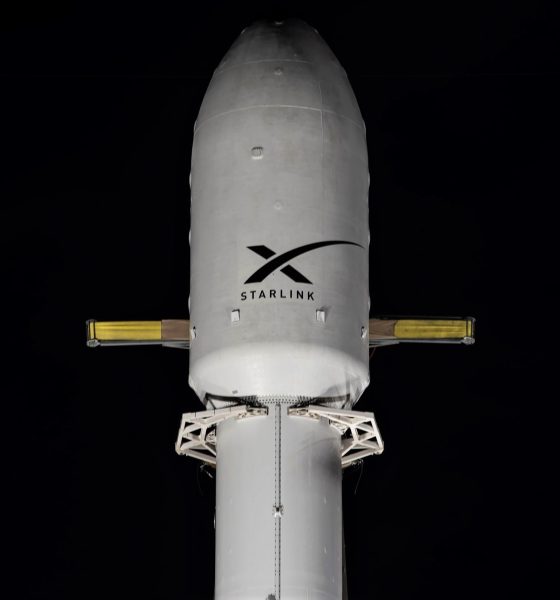

News
SpaceX confirms Starlink launch plans hours before Thursday liftoff
Update: Waiting longer than it ever has before, SpaceX finally confirmed it will attempt to launch Starlink 4-3 less than seven hours before the mission’s planned 6:12 pm EST (23:12 UTC), December 2nd liftoff. SpaceX has yet to publish any additional details or webcast links for the launch but should (in theory) do so within the next few hours.
SpaceX has raised Falcon 9 vertical for a record-breaking Starlink and rideshare mission known as Starlink Group 4 Launch 3 (4-3).
According to Spaceflight Now, Falcon 9 rolled out to SpaceX’s Cape Canaveral LC-40 launch pad and was expected to perform a static fire test as early as Monday, November 29th, briefly firing up the mystery flight-proven booster’s nine Merlin 1D engines to verify the rocket’s health. As of early Wednesday, that static fire has yet to happen, leaving SpaceX just ~36 hours to test the rocket before its current 5:57 pm EST (22:57 UTC), December 2nd launch target.
Despite its name, Starlink 4-3 will be SpaceX’s second Group 4 launch and is scheduled to deliver another 50-52 laser-linked Starlink V1.5 satellites to low Earth orbit. Normally, Starlink 4-3 would be carrying 53 Starlink satellites but SpaceX will instead swap out two or three Starlink satellites for two rideshare payloads from Earth observation company Blacksky.
Starlink 4-3 will be SpaceX’s fifth Starlink rideshare mission and second with Earth imaging satellites from Blacksky after Starlink V1 L9’s successful August 2020 launch. Each weighing around 60 kg (130 lb), Blacksky’s small ‘Gen2’ satellites are designed to capture images of Earth at resolutions of up to 0.9 meters per pixel. If successful, the launch will raise the number of operational Blacksky satellites in orbit from 8 to 10. Another two launches are expected to occur in the next two months for a total of 14 satellites.
Like past Starlink rideshares, SpaceX will likely launch Falcon 9 to a slightly higher orbit than usual – tailored to each customer’s needs. For SXRS-2, Spaceflight says Falcon 9 will deploy all Starlink and rideshare payloads in a (likely circular) 430 km (270 mi) low Earth orbit. In comparison, Falcon 9 deployed Starlink 4-1 in an orbit roughly 340 by 220 km.
For SpaceX, Starlink 4-3 will set at least two major spaceflight records. First, if all goes well, it will be SpaceX’s 27th launch of 2021 – a new record for annual launch cadence. Though CEO Elon Musk originally hoped for 40-48 launches this year, it appears that SpaceX will still manage around 29-31 by the end of December. However, if SpaceX managed to excise the apparent Starlink production gremlins that partly caused its launch cadence to plummet from 20 missions in the first half of 2021 to ~10 in the second half, 2022 could potentially meet Musk’s 2021 expectations.
Additionally, as pointed out by a Teslarati reader, Starlink 4-3 could also see Falcon 9 become the first American rocket in history to successfully complete more than 100 orbital launches in a row, narrowly beating out McDonnell Douglas’ retired Delta II rocket for the title. Earlier this year, many outlets already reported that SpaceX’s May 26th Starlink-28 launch was its 100th consecutive launch. While true in a very literal sense, it ignores SpaceX’s infamous Amos-6 Falcon 9 failure, which occurred well before liftoff but still destroyed both the rocket and payload. Following NASA’s DART mission earlier this month, which was Falcon 9’s unequivocal 100th launch success, Starlink 4-3 will be Falcon 9’s 101st orbital launch since Amos-6.
Only Russia’s R-7 (Soyuz) rockets – the most-launched rocket family in history – have successfully launched more times in a row. Since 1966, Soyuz rockets have launched more than 1900 times and the family has repeatedly completed 100 consecutively successful launches over its decades of operation. Eleven years after its debut, Falcon 9 currently stands at 127 fully successful launches – a lifetime away from matching Soyuz but still well on its way to a thoroughly impressive second place.
Stay tuned for official confirmation from SpaceX of Starlink 4-3’s pending static fire and December 2nd launch date.

News
Tesla FSD fleet is nearing 7 billion total miles, including 2.5 billion city miles
As can be seen on Tesla’s official FSD webpage, vehicles equipped with the system have now navigated over 6.99 billion miles.

Tesla’s Full Self-Driving (Supervised) fleet is closing in on almost 7 billion total miles driven, as per data posted by the company on its official FSD webpage.
These figures hint at the massive scale of data fueling Tesla’s rapid FSD improvements, which have been quite notable as of late.
FSD mileage milestones
As can be seen on Tesla’s official FSD webpage, vehicles equipped with the system have now navigated over 6.99 billion miles. Tesla owner and avid FSD tester Whole Mars Catalog also shared a screenshot indicating that from the nearly 7 billion miles traveled by the FSD fleet, more than 2.5 billion miles were driven inside cities.
City miles are particularly valuable for complex urban scenarios like unprotected turns, pedestrian interactions, and traffic lights. This is also the difference-maker for FSD, as only complex solutions, such as Waymo’s self-driving taxis, operate similarly on inner-city streets. And even then, incidents such as the San Francisco blackouts have proven challenging for sensor-rich vehicles like Waymos.
Tesla’s data edge
Tesla has a number of advantages in the autonomous vehicle sector, one of which is the size of its fleet and the number of vehicles training FSD on real-world roads. Tesla’s nearly 7 billion FSD miles then allow the company to roll out updates that make its vehicles behave like they are being driven by experienced drivers, even if they are operating on their own.
So notable are Tesla’s improvements to FSD that NVIDIA Director of Robotics Jim Fan, after experiencing FSD v14, noted that the system is the first AI that passes what he described as a “Physical Turing Test.”
“Despite knowing exactly how robot learning works, I still find it magical watching the steering wheel turn by itself. First it feels surreal, next it becomes routine. Then, like the smartphone, taking it away actively hurts. This is how humanity gets rewired and glued to god-like technologies,” Fan wrote in a post on X.
News
Tesla starts showing how FSD will change lives in Europe
Local officials tested the system on narrow country roads and were impressed by FSD’s smooth, human-like driving, with some calling the service a game-changer for everyday life in areas that are far from urban centers.

Tesla has launched Europe’s first public shuttle service using Full Self-Driving (Supervised) in the rural Eifelkreis Bitburg-Prüm region of Germany, demonstrating how the technology can restore independence and mobility for people who struggle with limited transport options.
Local officials tested the system on narrow country roads and were impressed by FSD’s smooth, human-like driving, with some calling the service a game-changer for everyday life in areas that are far from urban centers.
Officials see real impact on rural residents
Arzfeld Mayor Johannes Kuhl and District Administrator Andreas Kruppert personally tested the Tesla shuttle service. This allowed them to see just how well FSD navigated winding lanes and rural roads confidently. Kruppert said, “Autonomous driving sounds like science fiction to many, but we simply see here that it works totally well in rural regions too.” Kuhl, for his part, also noted that FSD “feels like a very experienced driver.”
The pilot complements the area’s “Citizen Bus” program, which provides on-demand rides for elderly residents who can no longer drive themselves. Tesla Europe shared a video of a demonstration of the service, highlighting how FSD gives people their freedom back, even in places where public transport is not as prevalent.
What the Ministry for Economic Affairs and Transport says
Rhineland-Palatinate’s Minister Daniela Schmitt supported the project, praising the collaboration that made this “first of its kind in Europe” possible. As per the ministry, the rural rollout for the service shows FSD’s potential beyond major cities, and it delivers tangible benefits like grocery runs, doctor visits, and social connections for isolated residents.
“Reliable and flexible mobility is especially vital in rural areas. With the launch of a shuttle service using self-driving vehicles (FSD supervised) by Tesla in the Eifelkreis Bitburg-Prüm, an innovative pilot project is now getting underway that complements local community bus services. It is the first project of its kind in Europe.
“The result is a real gain for rural mobility: greater accessibility, more flexibility and tangible benefits for everyday life. A strong signal for innovation, cooperation and future-oriented mobility beyond urban centers,” the ministry wrote in a LinkedIn post.
News
Tesla China quietly posts Robotaxi-related job listing
Tesla China is currently seeking a Low Voltage Electrical Engineer to work on circuit board design for the company’s autonomous vehicles.

Tesla has posted a new job listing in Shanghai explicitly tied to its Robotaxi program, fueling speculation that the company is preparing to launch its dedicated autonomous ride-hailing service in China.
As noted in the listing, Tesla China is currently seeking a Low Voltage Electrical Engineer to work on circuit board design for the company’s autonomous vehicles.
Robotaxi-specific role
The listing, which was shared on social media platform X by industry watcher @tslaming, suggested that Tesla China is looking to fill the role urgently. The job listing itself specifically mentions that the person hired for the role will be working on the Low Voltage Hardware team, which would design the circuit boards that would serve as the nervous system of the Robotaxi.
Key tasks for the role, as indicated in the job listing, include collaboration with PCB layout, firmware, mechanical, program management, and validation teams, among other responsibilities. The role is based in Shanghai.
China Robotaxi launch
China represents a massive potential market for robotaxis, with its dense urban centers and supportive policies in select cities. Tesla has limited permission to roll out FSD in the country, though despite this, its vehicles have been hailed as among the best in the market when it comes to autonomous features. So far, at least, it appears that China supports Tesla’s FSD and Robotaxi rollout.
This was hinted at in November, when Tesla brought the Cybercab to the 8th China International Import Expo (CIIE) in Shanghai, marking the first time that the autonomous two-seater was brought to the Asia-Pacific region. The vehicle, despite not having a release date in China, received a significant amount of interest among the event’s attendees.








